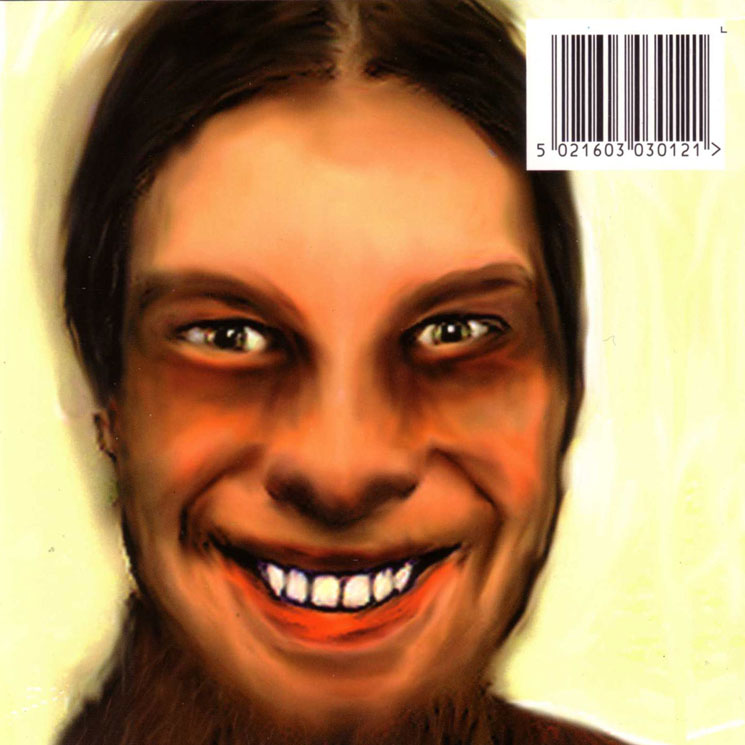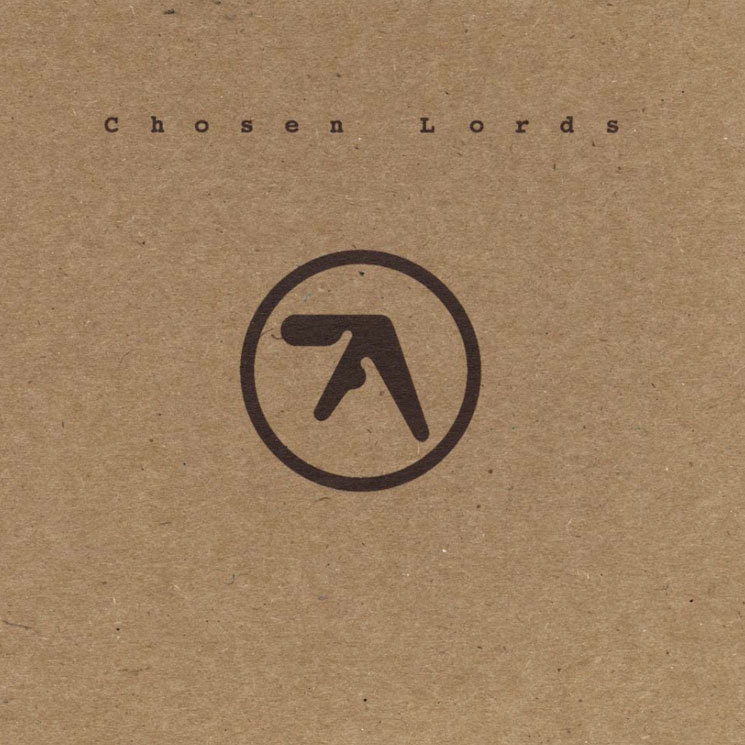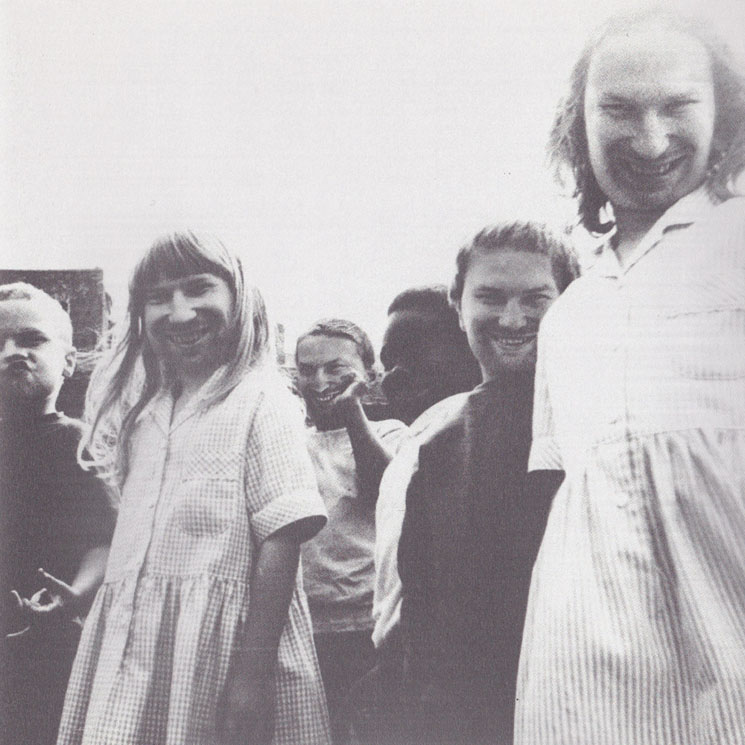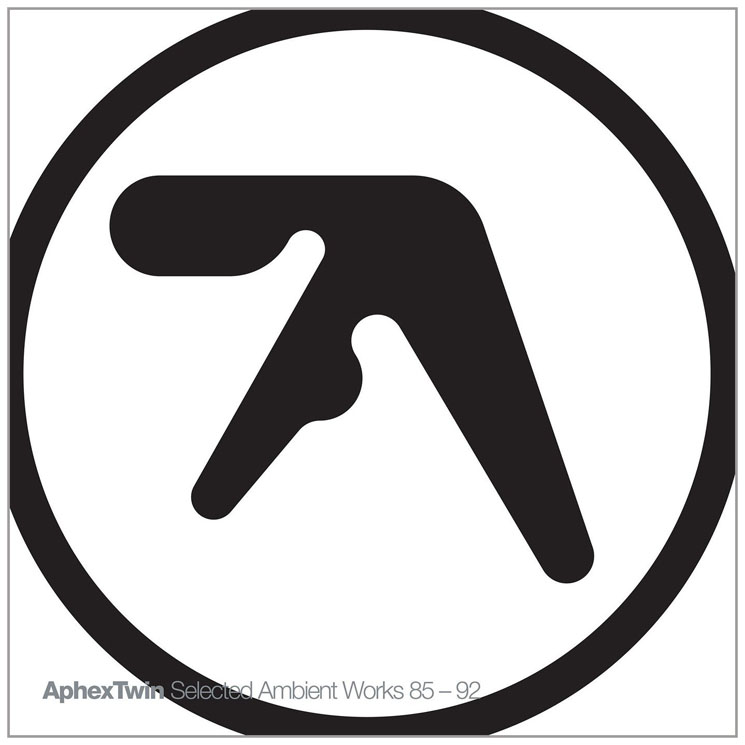Some say he lives in a bank with a recording studio in the vault; some say he drives a tank, pulls song ideas from lucid dreams, makes his own synthesizers and that he once played a show with some sandpaper and a blender. Some say that he'll play at your house party if you ask him nicely. The myths are endless and they only add to the mystique of his already esoteric music. In every shape, form and function, Richard D. James is unequivocally enigmatic.
Though mostly known for his AFX and Aphex Twin monikers, Richard D. James works under a plethora of pseudonyms; some are mere blips on the radar, others have a weight of releases with their own distinct style. He also co-owns Rephlex, one of the most forward-thinking records labels around since it formed in 1991.
Forget the long career, many guises and tantalizing folklore — if you just look at the music and nothing else, Richard D. James is still the most important figure in electronic music history. None have come close to his sheer ingenuity and downright artistry. There really isn't another musician out there with his imagination and the skill to bring those ideas to life.
Now, with a spate of releases in the last year or so, it appears that RDJ is officially back. Last year's Syro ended a six-year silence, and now he's released Orphaned Deejay Select 2006-2008, which got us thinking of all those great (and perhaps not so great) RDJ releases over the years.
Essential Albums:
5. Polygon Window
Surfing on Sine Waves
(1993)

Apart from a couple of EPs containing tracks already featured on Surfing on Sine Waves, this is sadly the only release under Polygon Window. Yet despite the lack of material, this is still one of RDJ's most fleshed-out monikers. Sine Waves is ridiculously consistent when compared to its cousins. One could even go so far as to put a single genre label on this album: acid techno. Yes, it's got ambient troughs and IDM jaunts dotted throughout, but this is, by and large, an acid techno record. Which is not to say that it will be dropped at an old-school night in some underground Chicago club — this is RDJ after all. His take on the genre is full of eerie synths, interesting drum patterns, and the occasional dizzying onslaught, but it's also quite calming at times. "Quino – Phec," for one, is a perfectly gentle outro, while "Portreath Harbour," despite being overtly electronic, somehow beckons you to the coast with every note. Don't let the recording year put you of either, this still sounds amazing.
4. Aphex Twin
...I Care Because You Do
(1995)

Like a good Pink Floyd song, ...I Care Because You Do is interesting from the outset, terrifying in the middle and just beautiful at the end. "Acrid Avid Jam Shred" is one of the best openers of any RDJ album — topped only by one, which we'll get to later. Its layers of percussion, introduced piece by piece, make it the ultimate slow-burner. Couple that with orchestral tones and playfully filtered electronics, and you've got yourself an Aphex classic. The proceedings do reach a menacing zenith with tracks like "Start as You Mean to Go On" and "Come on You Slags," where the drums feel like they're hammering nodes of your brain that seem to have been put aside for this purpose only, but this wouldn't be a great RDJ album without shaking you to your very core at least once. Slowly you start to emerge from the sinister warehouse into the warm bath of the album's final four tracks, with the tender "Alberto Balsalm" leading the pack. Following close behind is "Cow Cud Is a Twin," which is an anagram of Caustic Window (another RDJ alias), and only one of seven such jumbles on the album, but we'll let you figure out the rest.
3. AFX
Chosen Lords
(2006)

This entry, more than any other, is likely to upset people. Some are no doubt feverishly searching for the comments section right now to unleash fiery retorts from their fingertips, but just wait a sec. Yes, this is a compilation, and in many people's eyes, a poor selection of tracks from the beloved Analord series of EPs. Yes, it omits some excellent tracks like "Where's Your Girlfriend," "I'm Self Employed," and "Phonatacid" and all of Analords 1 and 2, which are arguably the best ones. Yes, it wasn't even pressed to vinyl. Forget all that, because the AFX moniker has never been about a unifying concept or feel with its releases. Aside from each Analord EP getting a bit livelier chronologically, there's not much setting these releases apart stylistically. They are essentially just selections of tracks themselves, and as far as selections go, Chosen Lords far surpasses any of the individual EPs. It has none of the minute-and-a-half doodlings found on a lot of the Analords, none of the creative debris that's often left over when dealing with such big ideas. From the gurgling, squelch-fest of "Fenix Funk 5" to the film-noir-meets-an-acid-wormhole journey of "XMD 5a," this album is a non-stop display of RDJ's synthesizer mastery.
2. Aphex Twin
Come to Daddy
(1997)

There is something about this mini-album that just aims straight for your inner child. Perhaps it's the samples of James's mother, being a completely stereotypical mam on "Come to Daddy [Mummy Mix]," or the toddler vocals on "To Cure a Weakling Child [Contour Regard]," but this release seems more reflective of RDJ's formative years than any other. The title track is, of course, pure evil, and anyone who's seen the astounding yet chilling video is probably scarred for life, but even that has some childlike elements to it. Come to Daddy might seem harsh-sounding at a glance, but if you pay attention you start to realize that it's actually wrapped in layers of playful glee. "Bucephalus Bouncing Ball," for example, is a frantic cacophony of sonic ricochets that could disorientate the sturdiest of people, but then it has that triumphant breakdown, which perfectly mimics the sound a ten-year-old hears when they finally reach the top of the hill. Just try and listen to "Funny Little Man" without laughing out loud. Come to Daddy also plays host to the oh-so-poignant "Flim" and "IZ-US," both of which are the ideal soundtrack for stumbling home at dawn after a truly great night.
1. Aphex Twin
Richard D. James Album
(1996)

It's very hard to make definitive statements about single songs in the vast sea of recordings out there, but opener "4" is the most beautiful electronic track ever produced. The sheer barrage of snares atop those sublime violins and enticing keys culminate into the most exquisite whirlwind of sounds that's really unlike anything else ever recorded. From that glorious beginning onwards, Richard D. James Album is jam-packed full of some of the most enthralling tracks of his career. Sure, it's not necessarily a release that you immediately fall in love with, but once you've given it the time, RDJ Album is endlessly rewarding. It's somewhat abrasive for the most part, but the album's gentle side roads are something to be marvelled at. Both "Fingerbib" and "Goon Gumpas" transport the listener to another plane of existence entirely, while the nebulous "Logon Rock Witch" comes across more like ceremonial music for some mystical creature rather than anything belonging to our realm. The heavier tracks, on the other hand, are loosely based on jungle, though in a lot of cases you'd have to concentrate quite hard to notice the similarities. "Girl/Boy Song" is one of the more obvious ones, with "Yellow Calx" (by far the best of the Calx's) and the superb "Peek 824545201" being a bit harder to identify. None of those, however, match the utter brilliance of "Corn Mouth" (sometimes written as "Carn Marth"), a track of such bewildering intensity that you'll likely want to pause the record for a time once it's finished. It's easy to see why RDJ put his own name on the album — this is one for the ages. RDJ Album is a record that can sit in your collection for years and still surprise you with every listen.
What to Avoid:

There isn't a huge amount of RDJ material that's bad, per se. For the most part, you can dive in at almost any time period and find something to your liking. There are a few releases, however, that pale in comparison to the rest.
One such release is 26 Mixes for Cash, a two-disc selection of random remixes that vary massively. James has openly admitted that he doesn't put any effort into remixing, and with a frivolous title like this one, you can figure from the get-go that it's not going to be anything special. That said, there are two reworks on 26 Mixes for Cash that are incredible. The AFX remix of "Flow Coma" by 808 State far out-shadows anything they've ever released. The Helston Flora remix of Baby Ford's "Normal" is also outstanding and shows the sheer gall of RDJ, who actually took a recording of Ford leaving a message expressing his distaste for the original remix and then reworked his complaint back into the final cut. These are, unfortunately, just highlights, though. On the whole, 26 Mixes for Cash is a slapdash affair with zero flow and some pretty lacklustre remixes, some of which — like the Philip Glass / David Bowie mashup of "Heroes" — are just a bit unseemly.
Another disappointment is 1995's Melodies from Mars. Though technically never released, merely given to friends at Rephlex and Warp Records, this could be considered one of Aphex Twin's seven albums. If so, it's miles behind the rest. Melodies from Mars does have an innocent feel that works on other releases, but the tracks — which are all untitled — plod along in a fairly boring manner. The whole album is like on-hold muzak for a carnival's customer service team. It's an oddly bland hiccup in a long, impressive career.
Further Listening:

Considering his downright prolific nature, this section could easily surpass the others in length. There are dozens of smaller releases and a few full-blown albums that are definitely worth mentioning here, if only briefly.
Firstly, there's numerous singles that don't belong to any larger release but nevertheless need some recognition. "On," "Donkey Rhubarb" and "Windowlicker" immediately spring to mind, but lesser-known tracks like "Naks 11 [Mono]," which is on a split release with LFO, and "Pac-Man," released way back in 1992 from the seldom used Power-Pill moniker, are worth a gander.
Then there are some bigger titles that you may be wondering why they haven't been mentioned yet. Selected Ambient Works 85-92, for one, is something that would probably be on the top of many people's list and talking about it here as a mere footnote is no doubt sacrilegious to some. It is incredibly seminal and has amazing tracks like "Xtal," "Pulsewidth" and "Heliosphan." If we're to believe the album title's dates, this puts some of these recordings in the hands of a 14-year-old RDJ, which is immensely impressive. Whether you like to admit it or not though, this sounds dated, and all the so-called charming elements like rough cuts, hissing and faders moved by hand as everything is recorded live to tape are not what makes a record great. This is by no means a slating of SAW 85-92 — it is possibly one of the best debut electronic albums of all time — but there are certain unmissable sound quality factors that stop it from making the list proper.
Drukqs, from 2001, also has some of the best Aphex Twin material out there, namely "Vordhosbn," "54 Cymru Beats" and "Cock/Ver10," all of which are sonic powerhouses, unseen anywhere else in music. Unfortunately, the album's jarring flips between orchestral piano interludes and rapid-fire drum blitzes make it too punctuated to be considered a true great.
A more recent gem is RDJ's work as the Tuss. There are just two EPs released under this name in 2007, Confederation Trough and the stunning Rushup Edge, but both are hugely enjoyable. The Tuss shows a more quirky side to RDJ than we're used to. It may seem strange to say — especially because he generally appears to do whatever he wants — but this particular guise sees RDJ at his most carefree, offering up colourful melodies, unbelievable drum programming, and mounds of fun.
Perhaps most importantly of all though is RDJ's recent mammoth upload of free unreleased tracks to a couple of SoundCloud pages earlier this year. There is the now-defunct user487363533001, which seems to only redirect you to another SC page under the name user18081971, but that one has over 200 tracks, all of which are free to download. This was a bizarre move on RDJ's part, but one that's been greatly appreciated the world over. This page also previously stated "Im VERY happy to report that I've found loads more old tapes I never encoded or gave to anybody, been looking a lot on / off last few months and found around seven tapes, most of which have 20+ tracks :))) Will upload/release soonish," so keep an eye out for more dumps, possibly from entirely new user names. Regardless of the espionage, this is a very exciting time for RDJ fans.
Though mostly known for his AFX and Aphex Twin monikers, Richard D. James works under a plethora of pseudonyms; some are mere blips on the radar, others have a weight of releases with their own distinct style. He also co-owns Rephlex, one of the most forward-thinking records labels around since it formed in 1991.
Forget the long career, many guises and tantalizing folklore — if you just look at the music and nothing else, Richard D. James is still the most important figure in electronic music history. None have come close to his sheer ingenuity and downright artistry. There really isn't another musician out there with his imagination and the skill to bring those ideas to life.
Now, with a spate of releases in the last year or so, it appears that RDJ is officially back. Last year's Syro ended a six-year silence, and now he's released Orphaned Deejay Select 2006-2008, which got us thinking of all those great (and perhaps not so great) RDJ releases over the years.
Essential Albums:
5. Polygon Window
Surfing on Sine Waves
(1993)

Apart from a couple of EPs containing tracks already featured on Surfing on Sine Waves, this is sadly the only release under Polygon Window. Yet despite the lack of material, this is still one of RDJ's most fleshed-out monikers. Sine Waves is ridiculously consistent when compared to its cousins. One could even go so far as to put a single genre label on this album: acid techno. Yes, it's got ambient troughs and IDM jaunts dotted throughout, but this is, by and large, an acid techno record. Which is not to say that it will be dropped at an old-school night in some underground Chicago club — this is RDJ after all. His take on the genre is full of eerie synths, interesting drum patterns, and the occasional dizzying onslaught, but it's also quite calming at times. "Quino – Phec," for one, is a perfectly gentle outro, while "Portreath Harbour," despite being overtly electronic, somehow beckons you to the coast with every note. Don't let the recording year put you of either, this still sounds amazing.
4. Aphex Twin
...I Care Because You Do
(1995)

Like a good Pink Floyd song, ...I Care Because You Do is interesting from the outset, terrifying in the middle and just beautiful at the end. "Acrid Avid Jam Shred" is one of the best openers of any RDJ album — topped only by one, which we'll get to later. Its layers of percussion, introduced piece by piece, make it the ultimate slow-burner. Couple that with orchestral tones and playfully filtered electronics, and you've got yourself an Aphex classic. The proceedings do reach a menacing zenith with tracks like "Start as You Mean to Go On" and "Come on You Slags," where the drums feel like they're hammering nodes of your brain that seem to have been put aside for this purpose only, but this wouldn't be a great RDJ album without shaking you to your very core at least once. Slowly you start to emerge from the sinister warehouse into the warm bath of the album's final four tracks, with the tender "Alberto Balsalm" leading the pack. Following close behind is "Cow Cud Is a Twin," which is an anagram of Caustic Window (another RDJ alias), and only one of seven such jumbles on the album, but we'll let you figure out the rest.
3. AFX
Chosen Lords
(2006)

This entry, more than any other, is likely to upset people. Some are no doubt feverishly searching for the comments section right now to unleash fiery retorts from their fingertips, but just wait a sec. Yes, this is a compilation, and in many people's eyes, a poor selection of tracks from the beloved Analord series of EPs. Yes, it omits some excellent tracks like "Where's Your Girlfriend," "I'm Self Employed," and "Phonatacid" and all of Analords 1 and 2, which are arguably the best ones. Yes, it wasn't even pressed to vinyl. Forget all that, because the AFX moniker has never been about a unifying concept or feel with its releases. Aside from each Analord EP getting a bit livelier chronologically, there's not much setting these releases apart stylistically. They are essentially just selections of tracks themselves, and as far as selections go, Chosen Lords far surpasses any of the individual EPs. It has none of the minute-and-a-half doodlings found on a lot of the Analords, none of the creative debris that's often left over when dealing with such big ideas. From the gurgling, squelch-fest of "Fenix Funk 5" to the film-noir-meets-an-acid-wormhole journey of "XMD 5a," this album is a non-stop display of RDJ's synthesizer mastery.
2. Aphex Twin
Come to Daddy
(1997)

There is something about this mini-album that just aims straight for your inner child. Perhaps it's the samples of James's mother, being a completely stereotypical mam on "Come to Daddy [Mummy Mix]," or the toddler vocals on "To Cure a Weakling Child [Contour Regard]," but this release seems more reflective of RDJ's formative years than any other. The title track is, of course, pure evil, and anyone who's seen the astounding yet chilling video is probably scarred for life, but even that has some childlike elements to it. Come to Daddy might seem harsh-sounding at a glance, but if you pay attention you start to realize that it's actually wrapped in layers of playful glee. "Bucephalus Bouncing Ball," for example, is a frantic cacophony of sonic ricochets that could disorientate the sturdiest of people, but then it has that triumphant breakdown, which perfectly mimics the sound a ten-year-old hears when they finally reach the top of the hill. Just try and listen to "Funny Little Man" without laughing out loud. Come to Daddy also plays host to the oh-so-poignant "Flim" and "IZ-US," both of which are the ideal soundtrack for stumbling home at dawn after a truly great night.
1. Aphex Twin
Richard D. James Album
(1996)

It's very hard to make definitive statements about single songs in the vast sea of recordings out there, but opener "4" is the most beautiful electronic track ever produced. The sheer barrage of snares atop those sublime violins and enticing keys culminate into the most exquisite whirlwind of sounds that's really unlike anything else ever recorded. From that glorious beginning onwards, Richard D. James Album is jam-packed full of some of the most enthralling tracks of his career. Sure, it's not necessarily a release that you immediately fall in love with, but once you've given it the time, RDJ Album is endlessly rewarding. It's somewhat abrasive for the most part, but the album's gentle side roads are something to be marvelled at. Both "Fingerbib" and "Goon Gumpas" transport the listener to another plane of existence entirely, while the nebulous "Logon Rock Witch" comes across more like ceremonial music for some mystical creature rather than anything belonging to our realm. The heavier tracks, on the other hand, are loosely based on jungle, though in a lot of cases you'd have to concentrate quite hard to notice the similarities. "Girl/Boy Song" is one of the more obvious ones, with "Yellow Calx" (by far the best of the Calx's) and the superb "Peek 824545201" being a bit harder to identify. None of those, however, match the utter brilliance of "Corn Mouth" (sometimes written as "Carn Marth"), a track of such bewildering intensity that you'll likely want to pause the record for a time once it's finished. It's easy to see why RDJ put his own name on the album — this is one for the ages. RDJ Album is a record that can sit in your collection for years and still surprise you with every listen.
What to Avoid:

There isn't a huge amount of RDJ material that's bad, per se. For the most part, you can dive in at almost any time period and find something to your liking. There are a few releases, however, that pale in comparison to the rest.
One such release is 26 Mixes for Cash, a two-disc selection of random remixes that vary massively. James has openly admitted that he doesn't put any effort into remixing, and with a frivolous title like this one, you can figure from the get-go that it's not going to be anything special. That said, there are two reworks on 26 Mixes for Cash that are incredible. The AFX remix of "Flow Coma" by 808 State far out-shadows anything they've ever released. The Helston Flora remix of Baby Ford's "Normal" is also outstanding and shows the sheer gall of RDJ, who actually took a recording of Ford leaving a message expressing his distaste for the original remix and then reworked his complaint back into the final cut. These are, unfortunately, just highlights, though. On the whole, 26 Mixes for Cash is a slapdash affair with zero flow and some pretty lacklustre remixes, some of which — like the Philip Glass / David Bowie mashup of "Heroes" — are just a bit unseemly.
Another disappointment is 1995's Melodies from Mars. Though technically never released, merely given to friends at Rephlex and Warp Records, this could be considered one of Aphex Twin's seven albums. If so, it's miles behind the rest. Melodies from Mars does have an innocent feel that works on other releases, but the tracks — which are all untitled — plod along in a fairly boring manner. The whole album is like on-hold muzak for a carnival's customer service team. It's an oddly bland hiccup in a long, impressive career.
Further Listening:

Considering his downright prolific nature, this section could easily surpass the others in length. There are dozens of smaller releases and a few full-blown albums that are definitely worth mentioning here, if only briefly.
Firstly, there's numerous singles that don't belong to any larger release but nevertheless need some recognition. "On," "Donkey Rhubarb" and "Windowlicker" immediately spring to mind, but lesser-known tracks like "Naks 11 [Mono]," which is on a split release with LFO, and "Pac-Man," released way back in 1992 from the seldom used Power-Pill moniker, are worth a gander.
Then there are some bigger titles that you may be wondering why they haven't been mentioned yet. Selected Ambient Works 85-92, for one, is something that would probably be on the top of many people's list and talking about it here as a mere footnote is no doubt sacrilegious to some. It is incredibly seminal and has amazing tracks like "Xtal," "Pulsewidth" and "Heliosphan." If we're to believe the album title's dates, this puts some of these recordings in the hands of a 14-year-old RDJ, which is immensely impressive. Whether you like to admit it or not though, this sounds dated, and all the so-called charming elements like rough cuts, hissing and faders moved by hand as everything is recorded live to tape are not what makes a record great. This is by no means a slating of SAW 85-92 — it is possibly one of the best debut electronic albums of all time — but there are certain unmissable sound quality factors that stop it from making the list proper.
Drukqs, from 2001, also has some of the best Aphex Twin material out there, namely "Vordhosbn," "54 Cymru Beats" and "Cock/Ver10," all of which are sonic powerhouses, unseen anywhere else in music. Unfortunately, the album's jarring flips between orchestral piano interludes and rapid-fire drum blitzes make it too punctuated to be considered a true great.
A more recent gem is RDJ's work as the Tuss. There are just two EPs released under this name in 2007, Confederation Trough and the stunning Rushup Edge, but both are hugely enjoyable. The Tuss shows a more quirky side to RDJ than we're used to. It may seem strange to say — especially because he generally appears to do whatever he wants — but this particular guise sees RDJ at his most carefree, offering up colourful melodies, unbelievable drum programming, and mounds of fun.
Perhaps most importantly of all though is RDJ's recent mammoth upload of free unreleased tracks to a couple of SoundCloud pages earlier this year. There is the now-defunct user487363533001, which seems to only redirect you to another SC page under the name user18081971, but that one has over 200 tracks, all of which are free to download. This was a bizarre move on RDJ's part, but one that's been greatly appreciated the world over. This page also previously stated "Im VERY happy to report that I've found loads more old tapes I never encoded or gave to anybody, been looking a lot on / off last few months and found around seven tapes, most of which have 20+ tracks :))) Will upload/release soonish," so keep an eye out for more dumps, possibly from entirely new user names. Regardless of the espionage, this is a very exciting time for RDJ fans.




